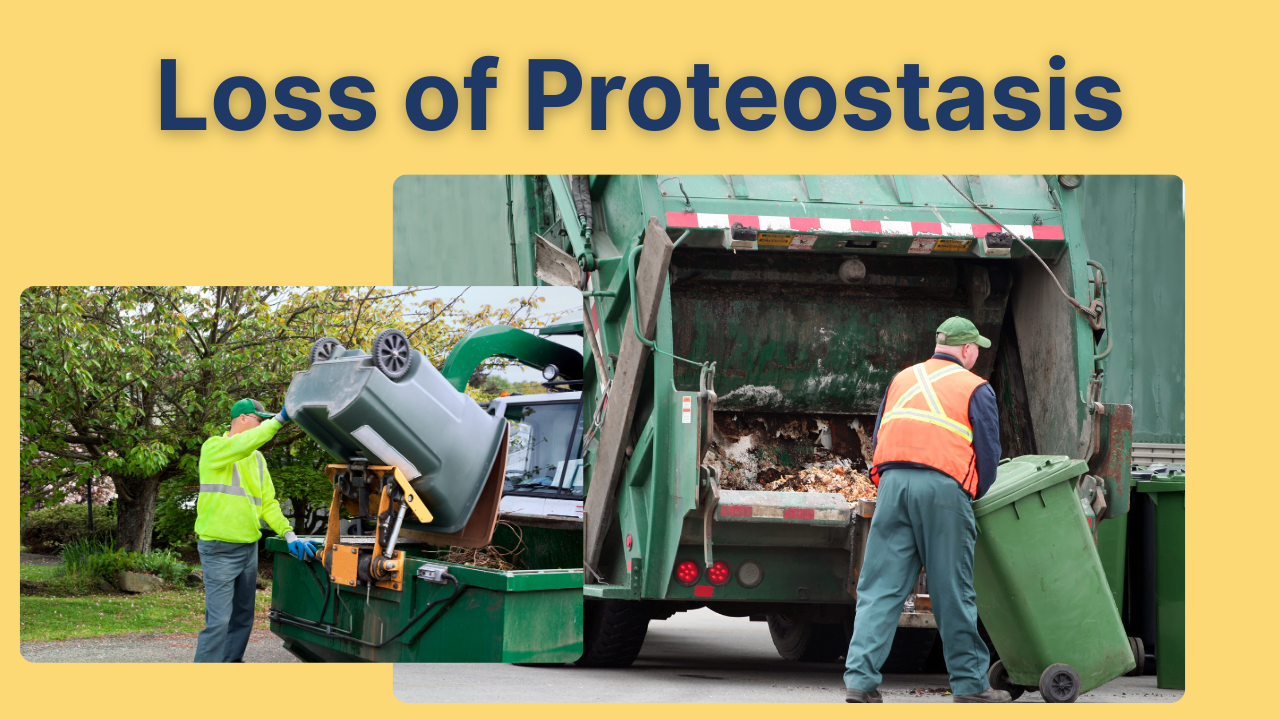
Hallmark #4 of Aging — Loss of Proteostasis
Your Body’s Internal Traffic System
Imagine your cells like a busy city, with thousands of “vehicles” (proteins) moving through tiny highways, delivering essential goods and keeping everything running smoothly. These proteins need to be correctly built, folded, and directed to where they’re needed. And if they break down or get stuck, they must be cleared out quickly.
This finely tuned balance is called proteostasis—short for protein homeostasis. And when this system starts to fail, like a city with stalled cars and blocked intersections, cellular traffic slows, toxins build up, and aging accelerates.
The loss of proteostasis is the fourth hallmark of aging, and it plays a major role in chronic diseases like Alzheimer’s, Parkinson’s, and even metabolic dysfunction.
But here’s the good news: we can do a lot to keep these cellular highways clear—and it doesn’t require anything extreme.
What Is Loss of Proteostasis? (And Why It Speeds Up Aging)
Proteins are the workhorses of your body. They build, repair, transport, and signal. But they must be properly folded and disposed of when damaged. Your cells rely on:
- Chaperone proteins to help fold new proteins correctly.
- Proteasomes and autophagy systems to break down the damaged or misfolded ones.
As we age, these systems decline. Misfolded proteins accumulate and begin to clump together, disrupting cellular function—just like stalled cars blocking traffic.
This buildup:
- Triggers inflammation.
- Damages mitochondria.
- Increases oxidative stress.
- And pushes cells closer to dysfunction or death.
Proteostasis failure is a key reason behind neurodegenerative diseases like Alzheimer’s and Parkinson’s, where toxic protein clumps (like beta-amyloid or alpha-synuclein) overwhelm brain cells.

The Hidden Culprit: Glycation and Blood Sugar
One of the main drivers of protein damage is a process called glycation. This happens when excess sugar in the blood binds to proteins, making them sticky, dysfunctional, and resistant to breakdown.
These sugar-damaged proteins are called AGEs (Advanced Glycation End-products), and they:
- Accelerate protein misfolding.
- Promote inflammation.
- Damage collagen and tissue elasticity.
- Increase the risk of heart disease, kidney dysfunction, and cognitive decline.
In short, uncontrolled blood sugar accelerates loss of proteostasis.
Why Metabolic Health Is Crucial
Maintaining stable blood sugar and metabolic flexibility is one of the most powerful things you can do to support proteostasis and slow aging.
Simple ways to support this:
- Prioritize low-glycemic, whole foods (leafy greens, healthy fats, quality proteins).
- Avoid ultra-processed foods and sugary snacks.
- Engage in regular physical activity—especially post-meal walks.
- Include intermittent fasting or time-restricted eating to give your body time to clean up misfolded proteins through autophagy.
- Focus on restorative sleep, as it helps the brain clear protein waste.
- Track your sugar levels with a CGM (Continuous Glucose Monito or an Over The Counter Biosensor) to learn what is triggering glucose spikes in your blood so you can avoid them.
Daily Habits to Support Proteostasis Naturally
Here are powerful yet practical things you can do:
- Exercise Regularly
- Both aerobic and resistance training boost autophagy and protein turnover.
- Exercise also induces heat shock proteins (HSPs), which help refold misfolded proteins.
- Prioritize Quality Sleep
- Deep sleep activates the glymphatic system, your brain’s nightly cleanup crew.
- Sleep deprivation increases beta-amyloid buildup and protein damage.
- Try Intermittent Fasting (IF)
- Fasting triggers cellular recycling pathways (autophagy) that help clear protein clumps.
- Even a 14–16 hour fast a few times a week can be beneficial.
- A simple way to start IF is to choose one day of the week to skip dinner.
- Calorie Restriction (CR) helps reduce loss of proteostasis, just 10-15% of CR had shown to reduce biological age and pace of aging.
- Eat Smart
- Support methylation and detox pathways with leafy greens, cruciferous vegetables, and sulfur-rich foods (onions, garlic).
- Reduce AGEs by cooking with gentler methods (steaming, boiling, low heat).
- Regulate Blood Sugar
- Incorporate vinegar or fiber before meals to avoid glucose spikes.
- Balance your meals with protein, fat, and fiber—limit high-carb meals alone (naked carbs).

Nature’s Tools: Senolytics and Hormone Support
As we age, senescent cells (old, non-functioning cells) accumulate and release signals that impair proteostasis.
Senolytics are compounds that help clear these cells. Some natural sources include:
- Fisetin (found in strawberries and apples)
- Quercetin (onions, capers)
- Curcumin (turmeric)
- EGCG (green tea)
Also, hormones like DHEA and growth hormone decline with age—but we can support them naturally:
- DHEA: Healthy omega 3 fats, strength training, and stress reduction support its levels.
- Growth hormone: Triggered by deep sleep (falling asleep before 11pm), fasting, high-intensity exercise, and L-arginine-rich foods (like nuts, seeds, and beans).
You Have More Control Than You Think
Loss of proteostasis is one of the body’s aging “software malfunctions,” but the science is clear: your daily actions can slow it down.
By reducing sugar exposure, managing stress, moving your body, getting sleep, and fueling your cells with nutrient-dense foods, you give your body the tools to stay clean and functional longer.
This is where prevention becomes power.
References
1. López-Otín et al., Cell (2023) – Hallmarks of Aging (Expanded View)
https://doi.org/10.1016/j.cell.2022.11.001
2. Chakraborty et al., Frontiers in Aging (2021) – Proteostasis and Neurodegenerative Disease
https://www.frontiersin.org/journals/aging-neuroscience/articles/10.3389/fnagi.2023.1281338/full
3. Almeida et al., Ageing Research Reviews (2024) – Lifestyle Strategies to Promote Proteostasis
https://doi.org/10.1016/j.arr.2023.102162
4. Hohn et al., Redox Biology (2017) – Happily (n)ever after: Aging in the context of oxidative stress, proteostasis loss and cellular senescence
https://doi.org/10.1016/j.redox.2016.12.001
5. G Brent Irvine, Omar M EI-Agnaf, et al., Mol Med (2008) – Protein Aggregation in the Brain: The Molecular Basis for Alzheimer’s and Parkinson’s Diseases
Stay connected with news and updates!
Join our mailing list to receive the latest news and updates from our team. Don't worry, your information will not be shared.
We hate SPAM. We will never sell your information, for any reason.

